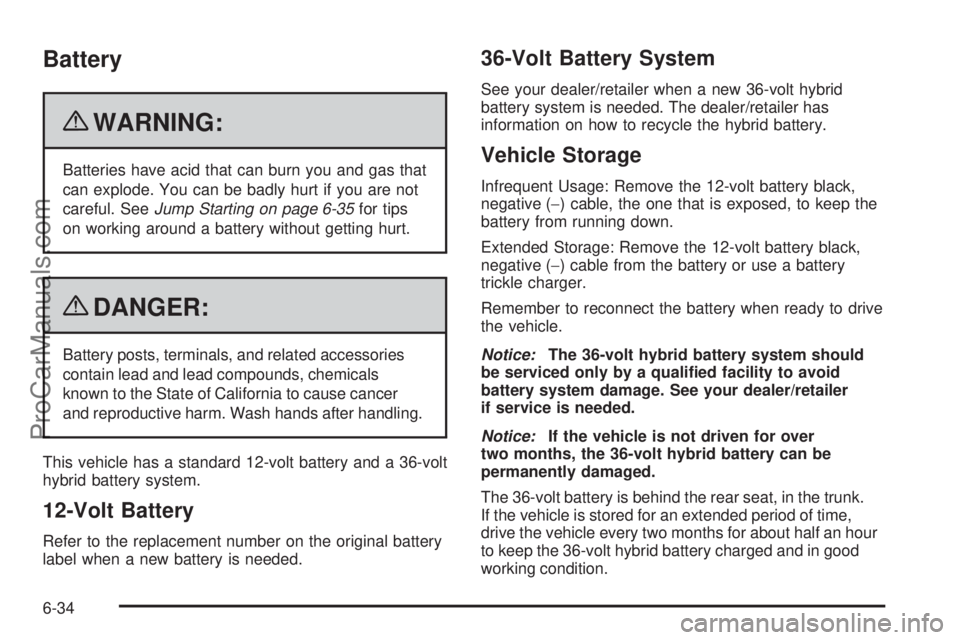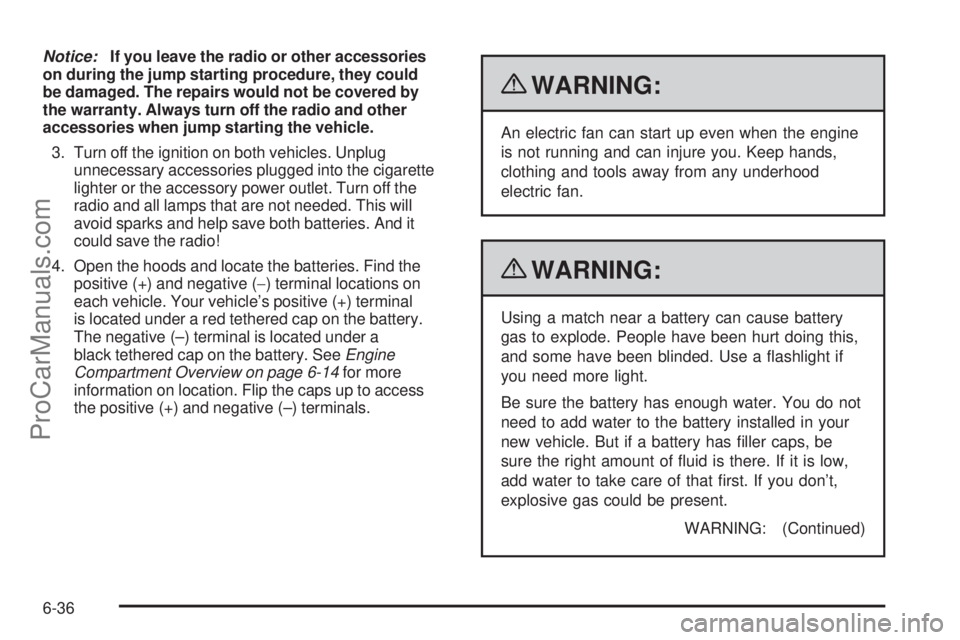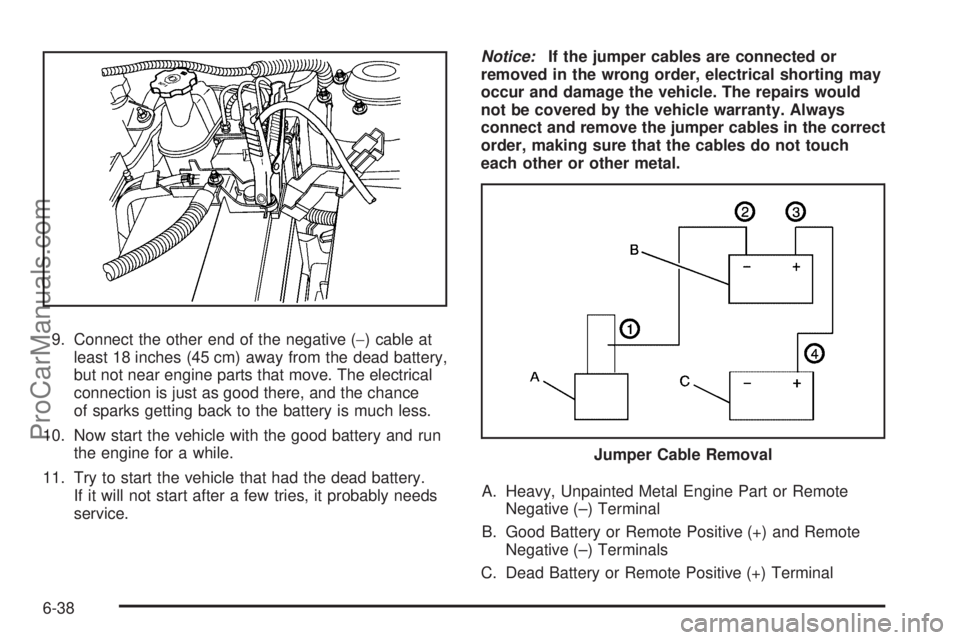jump start SATURN AURA HYBRID 2010 Owners Manual
[x] Cancel search | Manufacturer: SATURN, Model Year: 2010, Model line: AURA HYBRID, Model: SATURN AURA HYBRID 2010Pages: 400, PDF Size: 2.46 MB
Page 140 of 400

Shifting Out of Park
The vehicle is equipped with an electronic shift lock
release system. The shift lock release is designed to:
•Prevent ignition key removal unless the shift
lever is in P (Park) with the shift lever button fully
released, and
•Prevent movement of the shift lever out of P (Park),
unless the ignition is in ON/RUN or
ACC/ACCESSORY and the regular brake pedal is
applied.
The shift lock release is always functional except in the
case of an uncharged or low voltage (less than 9
volt) battery.
If the vehicle has an uncharged battery or a battery with
low voltage, try charging or jump starting the battery.
SeeJump Starting on page 6-35for more information.
To shift out of P (Park):
1. Apply the brake pedal.
2. Press the shift lever button.
3. Move the shift lever to the desired position.If you still are unable to shift out of P (Park):
1. Fully release the shift lever button.
2. While holding down the brake pedal, press the shift
lever button again.
3. Move the shift lever to the desired position.
If you still cannot move the shift lever from P (Park), see
your dealer/retailer.
Parking Over Things That Burn
{WARNING:
Things that can burn could touch hot exhaust
parts under the vehicle and ignite. Do not park
over papers, leaves, dry grass, or other things that
can burn.
3-32
ProCarManuals.com
Page 234 of 400

So do alcohol, drugs, and frustration. But even in
three-fourths of a second, a vehicle moving at 100 km/h
(60 mph) travels 20 m (66 feet). That could be a lot of
distance in an emergency, so keeping enough space
between the vehicle and others is important.
And, of course, actual stopping distances vary greatly
with the surface of the road, whether it is pavement or
gravel; the condition of the road, whether it is wet, dry, or
icy; tire tread; the condition of the brakes; the weight of
the vehicle; and the amount of brake force applied.
Avoid needless heavy braking. Some people drive
in spurts — heavy acceleration followed by heavy
braking — rather than keeping pace with traffic. This is a
mistake. The brakes might not have time to cool between
hard stops. The brakes will wear out much faster with a
lot of heavy braking. Keeping pace with the traffic and
allowing realistic following distances eliminates a lot of
unnecessary braking. That means better braking and
longer brake life.
If the engine ever stops while the vehicle is being driven,
brake normally but do not pump the brakes. If the brakes
are pumped, the pedal could get harder to push down.
If the engine stops, there will still be some power brake
assist but it will be used when the brake is applied. Once
the power assist is used up, it can take longer to stop and
the brake pedal will be harder to push.
Adding non-dealer/non-retailer accessories can affect
vehicle performance. SeeAccessories and Modi�cations
on page 6-3.Antilock Brake System (ABS)
This vehicle has the Antilock Brake System (ABS), an
advanced electronic braking system that helps prevent
a braking skid.
When the engine is started and the vehicle begins to
drive away, ABS checks itself. A momentary motor
or clicking noise might be heard while this test is going
on, and it might even be noticed that the brake pedal
moves a little. This is normal.
If there is a problem with
ABS, this warning light
stays on. SeeAntilock
Brake System (ABS)
Warning Light on
page 4-28.
Let us say the road is wet and you are driving safely.
Suddenly, an animal jumps out in front of you. You slam
on the brakes and continue braking. Here is what
happens with ABS:
A computer senses that the wheels are slowing down.
If one of the wheels is about to stop rolling, the computer
will separately work the brakes at each wheel.
5-4
ProCarManuals.com
Page 259 of 400

Service............................................................6-3
Accessories and Modifications..........................6-3
California Proposition 65 Warning.....................6-4
California Perchlorate Materials
Requirements.............................................6-4
Doing Your Own Service Work.........................6-4
Adding Equipment to the Outside
of the Vehicle.............................................6-5
Fuel................................................................6-6
Gasoline Octane............................................6-6
Gasoline Specifications....................................6-7
California Fuel...............................................6-7
Additives.......................................................6-7
Fuels in Foreign Countries...............................6-8
Filling the Tank..............................................6-9
Filling a Portable Fuel Container.....................6-11
Checking Things Under the Hood....................6-12
Hood Release..............................................6-12
Engine Compartment Overview.......................6-14
Engine Oil...................................................6-15
Engine Oil Life System..................................6-18
Engine Air Cleaner/Filter................................6-20
Automatic Transmission Fluid.........................6-22
Cooling System............................................6-22
Engine Coolant.............................................6-23
Engine Overheating.......................................6-28Windshield Washer Fluid................................6-30
Brakes........................................................6-31
Battery........................................................6-34
Jump Starting...............................................6-35
Headlamp Aiming...........................................6-39
Bulb Replacement..........................................6-39
Halogen Bulbs..............................................6-39
Taillamps, Turn Signal, Sidemarker,
Stoplamps and Back-up Lamps...................6-40
License Plate Lamp.....................................
.6-41
Replacement Bulbs.......................................6-42
Windshield Wiper Blade Replacement..............6-42
Tires..............................................................6-43
Tire Sidewall Labeling...................................6-44
Tire Terminology and Definitions.....................6-46
Inflation - Tire Pressure.................................6-49
High-Speed Operation...................................6-50
Tire Pressure Monitor System.........................6-51
Tire Pressure Monitor Operation.....................6-52
Tire Inspection and Rotation...........................6-55
When It Is Time for New Tires.......................6-57
Buying New Tires.........................................6-58
Different Size Tires and Wheels......................6-59
Uniform Tire Quality Grading..........................6-60
Wheel Alignment and Tire Balance..................6-61
Wheel Replacement......................................6-62
Section 6 Service and Appearance Care
6-1
ProCarManuals.com
Page 292 of 400

Battery
{WARNING:
Batteries have acid that can burn you and gas that
can explode. You can be badly hurt if you are not
careful. SeeJump Starting on page 6-35for tips
on working around a battery without getting hurt.
{DANGER:
Battery posts, terminals, and related accessories
contain lead and lead compounds, chemicals
known to the State of California to cause cancer
and reproductive harm. Wash hands after handling.
This vehicle has a standard 12-volt battery and a 36-volt
hybrid battery system.
12-Volt Battery
Refer to the replacement number on the original battery
label when a new battery is needed.
36-Volt Battery System
See your dealer/retailer when a new 36-volt hybrid
battery system is needed. The dealer/retailer has
information on how to recycle the hybrid battery.
Vehicle Storage
Infrequent Usage: Remove the 12-volt battery black,
negative (−) cable, the one that is exposed, to keep the
battery from running down.
Extended Storage: Remove the 12-volt battery black,
negative (−) cable from the battery or use a battery
trickle charger.
Remember to reconnect the battery when ready to drive
the vehicle.
Notice:The 36-volt hybrid battery system should
be serviced only by a quali�ed facility to avoid
battery system damage. See your dealer/retailer
if service is needed.
Notice:If the vehicle is not driven for over
two months, the 36-volt hybrid battery can be
permanently damaged.
The 36-volt battery is behind the rear seat, in the trunk.
If the vehicle is stored for an extended period of time,
drive the vehicle every two months for about half an hour
to keep the 36-volt hybrid battery charged and in good
working condition.
6-34
ProCarManuals.com
Page 293 of 400

Jump Starting
If the battery has run down, you may want to use
another vehicle and some jumper cables to start your
vehicle. Be sure to use the following steps to do it safely.
{WARNING:
Batteries can hurt you. They can be dangerous
because:
•They contain acid that can burn you.
•They contain gas that can explode or ignite.
•They contain enough electricity to burn you.
If you do not follow these steps exactly, some or
all of these things can hurt you.Notice:Ignoring these steps could result in costly
damage to the vehicle that would not be covered
by the warranty.
Trying to start the vehicle by pushing or pulling it
will not work, and it could damage the vehicle.
1. Check the other vehicle. It must have a 12-volt
battery with a negative ground system.
Notice:If the other vehicle’s system is not a 12-volt
system with a negative ground, both vehicles can
be damaged. Only use vehicles with 12-volt systems
with negative grounds to jump start your vehicle.
2. Get the vehicles close enough so the jumper cables
can reach, but be sure the vehicles are not touching
each other. If they are, it could cause a ground
connection you do not want. You would not be able
to start your vehicle, and the bad grounding could
damage the electrical systems.
To avoid the possibility of the vehicles rolling, set
the parking brake firmly on both vehicles involved
in the jump start procedure. Put an automatic
transmission in P (Park) or a manual transmission
in N (Neutral) before setting the parking brake.
6-35
ProCarManuals.com
Page 294 of 400

Notice:If you leave the radio or other accessories
on during the jump starting procedure, they could
be damaged. The repairs would not be covered by
the warranty. Always turn off the radio and other
accessories when jump starting the vehicle.
3. Turn off the ignition on both vehicles. Unplug
unnecessary accessories plugged into the cigarette
lighter or the accessory power outlet. Turn off the
radio and all lamps that are not needed. This will
avoid sparks and help save both batteries. And it
could save the radio!
4. Open the hoods and locate the batteries. Find the
positive (+) and negative (−) terminal locations on
each vehicle. Your vehicle’s positive (+) terminal
is located under a red tethered cap on the battery.
The negative (–) terminal is located under a
black tethered cap on the battery. SeeEngine
Compartment Overview on page 6-14for more
information on location. Flip the caps up to access
the positive (+) and negative (–) terminals.
{WARNING:
An electric fan can start up even when the engine
is not running and can injure you. Keep hands,
clothing and tools away from any underhood
electric fan.
{WARNING:
Using a match near a battery can cause battery
gas to explode. People have been hurt doing this,
and some have been blinded. Use a flashlight if
you need more light.
Be sure the battery has enough water. You do not
need to add water to the battery installed in your
new vehicle. But if a battery has filler caps, be
sure the right amount of fluid is there. If it is low,
add water to take care of that first. If you don’t,
explosive gas could be present.
WARNING: (Continued)
6-36
ProCarManuals.com
Page 296 of 400

9. Connect the other end of the negative (−) cable at
least 18 inches (45 cm) away from the dead battery,
but not near engine parts that move. The electrical
connection is just as good there, and the chance
of sparks getting back to the battery is much less.
10. Now start the vehicle with the good battery and run
the engine for a while.
11. Try to start the vehicle that had the dead battery.
If it will not start after a few tries, it probably needs
service.Notice:If the jumper cables are connected or
removed in the wrong order, electrical shorting may
occur and damage the vehicle. The repairs would
not be covered by the vehicle warranty. Always
connect and remove the jumper cables in the correct
order, making sure that the cables do not touch
each other or other metal.
A. Heavy, Unpainted Metal Engine Part or Remote
Negative (–) Terminal
B. Good Battery or Remote Positive (+) and Remote
Negative (–) Terminals
C. Dead Battery or Remote Positive (+) Terminal
Jumper Cable Removal
6-38
ProCarManuals.com
Page 374 of 400

Services Provided
•Emergency Fuel Delivery:Delivery of enough fuel
for the vehicle to get to the nearest service station.
•Lock-Out Service:Service is provided to unlock the
vehicle if you are locked out. A remote unlock may
be available if you have OnStar
®. For security
reasons, the driver must present identification
before this service is given.
•Emergency Tow From a Public Road or
Highway:Tow to the nearest Saturn retailer for
warranty service, or if the vehicle was in a crash and
cannot be driven. Assistance is also given when
the vehicle is stuck in sand, mud, or snow.
•Flat Tire Change:Service is provided to change a
flat tire with the spare tire. The spare tire, if
equipped, must be in good condition and properly
inflated. It is the owner’s responsibility for the repair
or replacement of the tire if it is not covered by
the warranty.
•Battery Jump Start:Service is provided to jump
start a dead battery.
•Trip Interruption Bene�ts and Assistance:If your
trip is interrupted due to a warranty failure, incidental
expenses may be reimbursed during the
5 years/100,000 miles (160 000 km) Powertrain
warranty period. Items considered are hotel, meals,
and rental car.
Services Not Included in Roadside
Assistance
•Impound towing caused by violation of any laws.
•Legal fines.
•Mounting, dismounting or changing of snow tires,
chains, or other traction devices.
•Towing or services for vehicles driven on a
non-public road or highway.
Services Speci�c to Canadian
Purchased Vehicles
•Fuel delivery:Reimbursement is approximately
$5 Canadian. Diesel fuel delivery may be
restricted. Propane and other fuels are not provided
through this service.
•Lock-Out Service:Vehicle registration is required.
•Trip Routing Service:Detailed maps of North
America are provided when requested either
with the most direct route or the most scenic route.
There is a limit of six requests per year. Additional
travel information is also available. Allow three
weeks for delivery.
8-8
ProCarManuals.com
Page 392 of 400

How the System Alarm is Activated...................3-18
How to Add Coolant to the Radiator..................6-26
How to Add Coolant to the Recovery Tank.........6-25
How to Check................................................6-50
How to Detect a Tamper Condition....................3-18
How to Inspect the Engine Air Cleaner/Filter.......6-20
How to Reset the Engine Oil Life System...........6-19
How to Turn Off the System Alarm....................3-18
How to Wear Safety Belts Properly...................2-16
Hydroplaning..................................................5-14
I
If a Crash Occurs...........................................8-12
If No Steam Is Coming From The Engine
Compartment..............................................6-29
If Steam Is Coming From The Engine
Compartment..............................................6-28
If the Off Indicator is Lit for an Adult-Size
Occupant...................................................2-70
If the On Indicator is Lit for a Child Restraint......2-69
Ignition Positions.............................................3-21
Ignition Transmission Lock Check....................... 7-9
Infants and Young Children, Restraints...............2-34
Inflation - Tire Pressure...................................6-49
Information Modes..........................................4-38Instrument Panel
Brightness..................................................4-12
Cluster.......................................................4-22
Insuring Your Vehicle.......................................8-12
Interior Mirror.................................................1-12
Intermediate Voltage Devices and Wiring............6-82
Introduction...................................................... 7-2
J
Jump Starting.................................................6-35
K
Keyless Entry
Remote (RKE) System................................... 3-4
Keyless Entry System....................................... 3-3
Keys............................................................... 3-2
L
Labeling, Tire Sidewall.....................................6-44
Lamps
Daytime Running (DRL)................................4-11
Dome ........................................................4-13
License Plate..............................................6-41
8
ProCarManuals.com